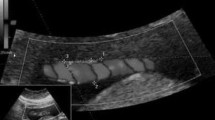Abstract
Purpose
To evaluate the relationship between sonographic measurements of umbilical cord coiling index during late second trimester of pregnancy and perinatal outcome.
Methods
This prospective study was conducted on two hundred pregnant women with uncomplicated, singleton pregnancy between 20 to 24 weeks of gestation. The antenatal umbilical coiling index (UCI) was calculated by doing a transabdominal ultrasound at the time of induction into the study as the reciprocal of the pitch of one complete vascular coil. The patients were followed up till delivery and any adverse antenatal and/or perinatal event was noted.
Results
The mean value for the UCI was noted to be 0.36 + 0.07 coils/cm with a 95 % CI of 0.35–0.37. The values for the 10th and the 90th percentile were 0.26 and 0.46 coils/cm respectively. Accordingly the cases were divided into three groups- hypocoiled (UCI <10th percentile)-18, normocoiled (UCI between 10th–90th percentile)-162 and hypercoiled (UCI >90th percentile)-20. Hypocoiling was observed to be significantly associated with preterm labour pains (P value 0.0344), oligohydramnios (P value 0.0021), intrapartum foetal heart rate abnormalities (P value 0.0012), instrumental vaginal delivery (P value 0.0275) and low birth weight (P value 0.0344). Hypercoiling was found to be significantly associated with intrauterine growth restriction (P value 0.0323), foetal heart rate abnormalities during labour (0.0399) and low birth weight (P value 0.0095).
Conclusion
Abnormal umbilical coiling index in the form of either hypo- or hypercoiling is associated with several adverse antenatal and neonatal outcomes.

Similar content being viewed by others
Abbreviations
- AFI:
-
Amniotic fluid index
- APH:
-
Antepartum hemorrhage
- FHR:
-
Fetal heart rate
- IUGR:
-
Intrauterine growth restriction
- MSL:
-
Meconium stained liquor
- NICU:
-
Neonatal intensive care unit
- PIH:
-
Pregnancy induced hypertension
- PROM:
-
Premature rupture of membranes
- PTLP’s:
-
Preterm labour pains
- UCI:
-
Umbilical coiling index
References
Chitra T, Sushanth YS, Raghavan S (2012) Umbilical coiling index as a marker of perinatal outcome: an analytical study. Obstet Gynecol Int. doi:10.1155/2012/213689
Edmonds HW (1954) The spiral twist of the normal umbilical cord in twins and in singletons. Am J Obstet Gynecol 67:102–120
de Laat MW, Franx A, van Alderen ED, Nikkels PG, Visser GH (2005) The umbilical coiling index, a review of the literature. J Matern Fetal Neonatal Med 17:93–100
Lacro RV, Jones KL, Benirschke K (1987) The umbilical cord twist: origin, direction, and relevance. Am J Obstet Gynecol 157:833–838
Strong TH, Jarles DL, Vega JS, Feldman DB (1994) The umbilical coiling index. Am J Obstet Gynecol 170:29–32
Rana J, Ebert GA, Kappy KA (1995) Adverse perinatal outcome in patients with an abnormal umbilical coiling index. Obstet Gynecol 85:573–577
Predanic M, Perni SC, Chasen ST, Baergen RN, Chervenak FA (2005) Assessment of umbilical cord coiling during the routine fetal sonographic anatomic survey in the second trimester. J Ultrasound Med 24:185–191
Sharma B, Bhardwaj N, Gupta S, Gupta PK, Verma A, Malviya K (2012) Association of umbilical coiling index by colour Doppler ultrasonography at 18–22 weeks of gestation and perinatal outcome. J Obstet Gynaecol India 62:650–654
de Laat MW, Franx A, Nikkels PG, Visser GH (2006) Prenatal ultrasonographic prediction of the umbilical coiling index at birth and adverse pregnancy outcome. Ultrasound Obstet Gynecol 28:704–709
de Laat MW, Franx A, Bots ML, Visser GH, Nikkels PG (2006) Umbilical coiling index in normal and complicated pregnancies. Obstet Gynecol 107:1049–1055
Jo YS, Jang DK, Lee G (2011) The sonographic umbilical cord coiling in late second trimester of gestation and perinatal outcomes. Int J Med Sci 8:594–598
van Diik CC, Franx A, de Laat MW, Bruinse HW, Visser GH, Nikkels PG (2002) The umbilical coiling index in normal pregnancy. J Matern Fetal Neonatal Med 11:280–283
Kashanian M, Akbariana A, Kouhpayehzadeh J (2006) The umbilical coiling index and adverse perinatal outcome. Int J Gynecol Obst 95:8–13
Nakai Y, Imanaka M, Nishio J, Ogita S (1997) Umbilical venous pulsation and regional circulatory disturbance. Ultrasound Med Biol 23:1165–1169
Machin GA, Ackerman J, Gilbert-Barness E (2000) Abnormal umbilical cord coiling is associated with adverse perinatal outcomes. Pediatr Dev Pathol 3:462–471
Ezimokhai M, Rizk DEE, Thomas L (2000) Maternal risk factors for abnormal vascular coiling of the umbilical cord. Am J Obstet Gynecol 17:441–446
de Laat MW, van Alderen Elise D, Franx A et al (2007) The umbilical coiling index in complicated pregnancy. Obstet Gynecol Surv 62:357–358
Patil NS, Kulkarni SR, Ohitashwa R (2013) Umbilical cord coiling index and perinatal outcome. J Clin Diagn Res 7:1675–1677
Strong TH, Elliott JP, Radin TG (1993) Non-coiled umbilical blood vessels: a new marker for the fetus at risk. Obstet Gynecol 81:409–411
Predanic M, Perni SC, Chasen Stephen T, Baergen RN, Chervenak F (2005) Ultrasound evaluation of abnormal umbilical cord coiling in second trimester of gestation in association with adverse pregnancy outcome. Am J Obstet Gynecol 193:387–394
Ercal T, Lacin S, Altunyurt S, Saygili U, Cinar O, Mumcu A (1996) Umbilical coiling index: is it a marker for the fetus at risk? Br J Clin Pract 50:254–256
Jessop FA, Lees CC, Pathak S, Hook CE, Sebire NJ (2014) Umbilical cord coiling: clinical outcomes in an unselected population and systematic review. Virchows Arch 464:105–112
Conflict of interest
We declare that we have no conflict of interest.
Author information
Authors and Affiliations
Corresponding author
Rights and permissions
About this article
Cite this article
Mittal, A., Nanda, S. & Sen, J. Antenatal umbilical coiling index as a predictor of perinatal outcome. Arch Gynecol Obstet 291, 763–768 (2015). https://doi.org/10.1007/s00404-014-3456-5
Received:
Accepted:
Published:
Issue Date:
DOI: https://doi.org/10.1007/s00404-014-3456-5




